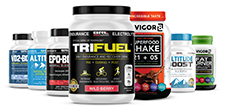Nutrition Mistakes Runners Make

By Melissa Mitri, RD
Proper nutrition is non-negotiable for runners. What and when you choose to eat is crucial so you can properly fuel yourself, feel energized during your runs and recover. Following are the top nutrition mistakes runners make, and how to prevent them.
Skipping Breakfast
Many runners skip breakfast if they do early runs, for fear it will weigh them down. However, if you don’t drink or eat anything, chances are you’ll start to lose steam after the first 2-3 miles. If you’re heading right out the door after you wake up, make sure you eat something high in carbs and low in fiber, protein and fat. Protein, fat and fiber can be hard to digest and will feel like lead in your stomach. Some good choices are a few bites of a banana or dates, or a couple handfuls of low-fiber cereal. If eating anything bothers your stomach, then you can try 4 oz of orange juice for some sugar and electrolytes.
If you won’t be running for at least 30 minutes, have a slice of toast with nut butter or 2 scoops of our TriFuel Endurance and Recovery Drink with 8 oz of water.
Eating Too Much Fiber
Fiber is typically your friend, but not when it comes to running. Eating high-fiber foods like fruits with skin, vegetables, beans or whole grains before your run can cause gas, bloating and diarrhea. This is because fiber is only partially digested in our bodies and creates bulk. While this is a good thing when it comes to your waistline, since it keeps you full without adding a lot of calories, fiber can make you feel weighed down during your runs. Save your high-fiber foods for a post-run snack or your off days.
Not Refueling During Long Runs
If you’re doing a light run for 3-4 miles or are running for less than an hour, you most likely will not need to refuel, as you will have enough reserve in your glycogen stores to pull you through. However, if you’re running longer than 60-90 minutes, these stores will start to diminish.
You should refuel within the first 90 minutes of your run, and then every 45-60 minutes thereafter, depending on your energy level. This fuel should be a high carbohydrate, electrolyte-containing food or drink.
Gummies, jelly beans or sports gels are great food options that are easy to carry around. If you prefer a liquid, or solid food bothers you during your runs, try our TriFuel Energy and Recovery Drink after every 90-minute segment of your run. This energy drink provides necessary fluids, 30 grams of carbohydrates to sustain your energy and electrolytes that are depleted during long runs such as sodium, potassium and magnesium.
Not Drinking Enough Water
Adequate water intake is critical before, during and after your runs. Dehydration can lead to fatigue, dizziness, nausea and muscle cramping. A general rule of thumb is to consume 4-6 oz of water or an electrolyte-containing beverage for every 30 minutes of running.
Your nutrition has a profound impact on your running performance. Give your body what it needs to endure and recover by avoiding running on an empty stomach, limiting fiber, refueling and drinking plenty of water.
Take the next step in your training regimen: Try any BRL Sports supplement risk-free! If our natural nutritional products aren’t the best you’ve ever used, simply return your purchase for a 100% refund — no questions asked!
Also in Inspiration & Perspiration

High Altitude Supplements: Complete Guide to Training & Prevention (Altitude Sickness Solutions)
Support endurance and reduce altitude stress with supplements that improve oxygen efficiency, stamina, and recovery in high-altitude conditions.

Best Supplements For Runners: Complete Guide By Training Phase (Base, Peak, Taper & Race Day)
Discover the best supplements for runners by training phase—base, peak, taper, and race day—to boost endurance, recovery, and performance.

Creatine for Endurance vs. Sprint Efforts
Creatine isn’t just for power—learn how it boosts sprint speed, recovery, and endurance performance.


